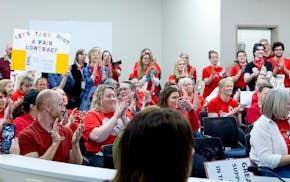St. Paul's quest to rebuild the fabled green stairs on the city's West Side has hit a steep obstacle: an elevator.
City officials and community members were confident they had a lock on federal stimulus funding and could erect a new 200-step tower in spring. Folks could get back to walking downtown or to punishing their lungs and legs for exercise; 350 people used to use the stairs daily.
Turns out, an official with the Federal Highway Administration said if there are going to be new stairs, there needs to be an elevator, because not everybody can walk the steps.
"If it isn't accessible to everybody, then it is a violation of civil rights," Christopher Douwes, trails and enhancements program manager, wrote last month in an e-mail. Even if federal funds aren't used, an elevator is needed, he added.
That's not what city officials wanted to hear. They said that while they're mindful of accessibility issues and have made design upgrades, an elevator poses a major safety risk.
Mayor Chris Coleman's Advisory Committee on People with Disabilities signed off on the project. The Minnesota Department of Transportation offered its support.
"It's incredibly vast bureaucratic overkill," said Council Member Dave Thune, whose ward includes the West Side. "It's really a disappointment to the neighbors who've worked on it."
City officials and a community group worked quickly over a yearlong period to find a new design after the 93-year-old stair tower was demolished last year after being damaged when a boulder loosened by a storm slammed into it. It was a neighborhood landmark that provided practical transit, grueling cardiovascular training and sweeping views of the Mississippi River Valley and the downtown skyline.
The challenge to rebuilding was finding the $2 million for construction. When the American Recovery and Reinvestment Act came along, city engineers jumped at the opportunity to apply.
When the elevator problem came up, the city resubmitted its application with some modifications, such as putting signs on a sidewalk that leads up to the bluff and adding handicapped parking spots at the top and bottom. A viewing deck at the top of the bluff would be wheelchair-accessible, and rest areas would be built on the stair landings.
City engineer John Maczko acknowledged that people who use wheelchairs wouldn't be able to use the stairs.
"If we didn't believe that we addressed all the access issues, we wouldn't have put this forward," he said. "It's not always possible to accommodate all needs."
Money isn't the issue, safety is, he said. Still, the estimated cost of building the elevator would be about $2.1 million. Yearly maintenance would cost about $100,000, according to city estimates.
Safety, access debated
Many folks on the West Side were taken aback when they heard the news, said Carol Swenson, who cochaired the committee that worked on the new tower design.
"An elevator there is just not a good thing," she said. Among the concerns: What if someone gets stuck? What if a stranger locks a child inside? What about crime?
But others might counter: What about access for all?
Margot Imdieke Cross, accessibility specialist with the State Council on Disability, said she wasn't familiar with the St. Paul situation, but noted that elevators have been installed in various transportation projects with security systems.
She said the group of people who would be affected is likely larger than just those who use wheelchairs. It would include older people and those who have balance problems.
"If tax dollars are paying for it, by gosh, we better be able to have access to it," Imdieke Cross said. "Why would I want to pay for something I wouldn't be able to use?"
When asked about the situation Wednesday, the federal agency issued this statement: "The Federal Highway Administration fully supports the Americans with Disabilities Act (ADA). In keeping with FHWA's role in enforcing the ADA in the public right of way, FHWA is consulting with all the appropriate agencies on the matter."
St. Paul officials aren't sure where that leaves the project. Still, it's a priority for Coleman, who lives on the West Side and has used the stairs to train for backpacking trips. "We'll continue to push for this thing," said his spokesman, Bob Hume.
Chris Havens • 612-673-4148

Lakeville teachers, district reach tentative contract agreement

Pulitzer Prize winner Hernan Diaz, Oscar-anointed Percival Everett and bestseller Rebecca Makkai coming to Hopkins for Pen Pals

Meet the affordable housing champion fighting for St. Paul's West Side

